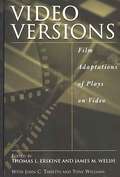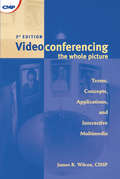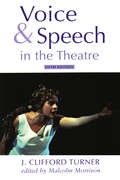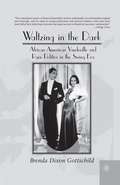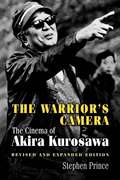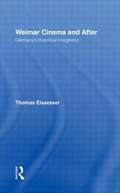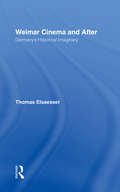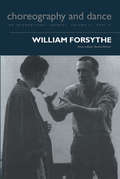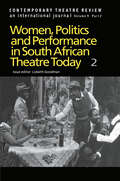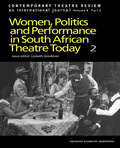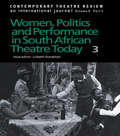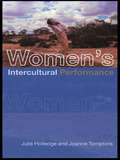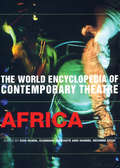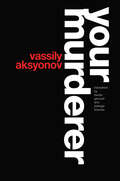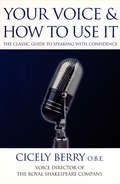- Table View
- List View
Uva's Rigging Guide for Studio and Location
by Michael Uva Sabrina UvaReaders of Mike Uva's GRIP BOOK who are interested in more detailed information on the work of the grip department will welcome his new rigging manual, clearly detailing all the ways to mount cameras and lights both on a set as well as on location. The book covers the latest truss systems, rigging equipment and portable stages, as well as lifts, boom arms and camera mounts for every type of moving vehicle. The book is not limited to equipment specifications, however; Uva offers tips and tricks throughout in order to make the process of setting up and shooting safer and more efficient. Grips often need to invent makeshift solutions in a short time, and Uva shares many such devices developed over his years in the film and TV industry. This book will help grips and key grips move on to the bigger feature projects and commercials that require this equipment. It will also be useful for directors of photography and producers in pre-planning the required equipment for specific shots.
Video Versions: Film Adaptations of Plays on Video (Non-ser.)
by Thomas L. Erskine James M. WelshMany of our favorite films began as plays—some as well known as Shakespeare's Romeo and Juliet, and some not so well known as You've Got Mail's origin, a 1937 play Parfumerie by Miklos Laszlo. Video Versions identifies nearly 300 films and their theatrical origins, providing readers with an overview of the films and highlighting similarities and differences to the source plays. Perfect for teachers, students, and anyone interested in theater and film, it is the most complete resource available for video versions of plays.Each entry provides: the original play's title, author, and year of publication; the name of the film, year of production, director and adapter; the main cast and the characters they play; running time and rating if available. Following a plot summary, a critical analysis provides the similarities and differences of the play and film, including character and plot changes, setting, missing or added scenes, special film techniques, and behind-the-scenes information such as who turned down or lost particular parts when the play was adapted to film. A short list of sources for further reading follows each entry. Information about contacting distributors—for obtaining the films—is included in the introduction and an extensive index completes the volume.
Videoconferencing: The Whole Picture
by James R. WilcoxFirst published in 2000. Routledge is an imprint of Taylor & Francis, an informa company.
Videoconferencing: The Whole Picture
by James R. WilcoxFirst published in 2000. Routledge is an imprint of Taylor & Francis, an informa company.
Voice and Speech in the Theatre
by J. Clifford Turner Malcolm MorrisonThis is a classic book on voice and speech, designed for actors at all levels. One of the great voice teachers of his day, J. Clifford Turner here uses simple and direct language to impart the necessary technical 'basics' of speech and voice.
Voice and Speech in the Theatre
by J. Clifford Turner Malcolm MorrisonThis is a classic book on voice and speech, designed for actors at all levels. One of the great voice teachers of his day, J. Clifford Turner here uses simple and direct language to impart the necessary technical 'basics' of speech and voice.
Waltzing in the Dark: African American Vaudeville and Race Politics in the Swing Era
by NA NA Brenda Dixon GottschildThe career of Norton and Margot, a ballroom dance team whose work was thwarted by the racial tenets of the era, serves as the barometer of the times and acts as the tour guide on this excursion through the worlds of African American vaudeville, black and white America during the swing era, the European touring circuit, and pre-Civil Rights era racial etiquette.
The Warrior's Camera: The Cinema of Akira Kurosawa
by Stephen PrinceThe Japanese film director Akira Kurosawa, who died at the age of 88, has been internationally acclaimed as a giant of world cinema. Rashomon, which won both the Venice Film Festival's grand prize and an Academy Award for best foreign-language film, helped ignite Western interest in the Japanese cinema. Seven Samurai and Yojimbo remain enormously popular both in Japan and abroad. In this newly revised and expanded edition of his study of Kurosawa's films, Stephen Prince provides two new chapters that examine Kurosawa's remaining films, placing him in the context of cinema history. Prince also discusses how Kurosawa furnished a template for some well-known Hollywood directors, including Martin Scorsese, Steven Spielberg, and George Lucas. Providing a new and comprehensive look at this master filmmaker, The Warrior's Camera probes the complex visual structure of Kurosawa's work. The book shows how Kurosawa attempted to symbolize on film a course of national development for post-war Japan, and it traces the ways that he tied his social visions to a dynamic system of visual and narrative forms. The author analyzes Kurosawa's entire career and places the films in context by drawing on the director's autobiography--a fascinating work that presents Kurosawa as a Kurosawa character and the story of his life as the kind of spiritual odyssey witnessed so often in his films. After examining the development of Kurosawa's visual style in his early work, The Warrior's Camera explains how he used this style in subsequent films to forge a politically committed model of filmmaking. It then demonstrates how the collapse of Kurosawa's efforts to participate as a filmmaker in the tasks of social reconstruction led to the very different cinematic style evident in his most recent films, works of pessimism that view the world as resistant to change.
Weimar Cinema and After: Germany's Historical Imaginary
by Thomas ElsaesserGerman cinema of the 1920s is still regarded as one of the 'golden ages' of world cinema. Films such as The Cabinet of Dr Caligari, Dr Mabuse the Gambler, Nosferatu, Metropolis, Pandora's Box and The Blue Angel have long been canonised as classics, but they are also among the key films defining an image of Germany as a nation uneasy with itself. The work of directors like Fritz Lang, F.W. Murnau and G.W. Pabst, which having apparently announced the horrors of fascism, while testifying to the traumas of a defeated nation, still casts a long shadow over cinema in Germany, leaving film history and political history permanently intertwined. Weimar Cinema and After offers a fresh perspective on this most 'national' of national cinemas, re-evaluating the arguments which view genres and movements such as 'films of the fantastic', 'Nazi Cinema', 'film noir' and 'New German Cinema' as typically German contributions to twentieth century visual culture. Thomas Elsaesser questions conventional readings which link these genres to romanticism and expressionism, and offers new approaches to analysing the function of national cinema in an advanced 'culture industry' and in a Germany constantly reinventing itself both geographically and politically. Elsaesser argues that German cinema's significance lies less in its ability to promote democracy or predict fascism than in its contribution to the creation of a community sharing a 'historical imaginary' rather than a 'national identity'. In this respect, he argues, German cinema anticipated some of the problems facing contemporary nations in reconstituting their identities by means of media images, memory, and invented traditions.
Weimar Cinema and After: Germany's Historical Imaginary (PDF)
by Thomas ElsaesserGerman cinema of the 1920s is still regarded as one of the 'golden ages' of world cinema. Films such as The Cabinet of Dr Caligari, Dr Mabuse the Gambler, Nosferatu, Metropolis, Pandora's Box and The Blue Angel have long been canonised as classics, but they are also among the key films defining an image of Germany as a nation uneasy with itself. The work of directors like Fritz Lang, F.W. Murnau and G.W. Pabst, which having apparently announced the horrors of fascism, while testifying to the traumas of a defeated nation, still casts a long shadow over cinema in Germany, leaving film history and political history permanently intertwined. Weimar Cinema and After offers a fresh perspective on this most 'national' of national cinemas, re-evaluating the arguments which view genres and movements such as 'films of the fantastic', 'Nazi Cinema', 'film noir' and 'New German Cinema' as typically German contributions to twentieth century visual culture. Thomas Elsaesser questions conventional readings which link these genres to romanticism and expressionism, and offers new approaches to analysing the function of national cinema in an advanced 'culture industry' and in a Germany constantly reinventing itself both geographically and politically. Elsaesser argues that German cinema's significance lies less in its ability to promote democracy or predict fascism than in its contribution to the creation of a community sharing a 'historical imaginary' rather than a 'national identity'. In this respect, he argues, German cinema anticipated some of the problems facing contemporary nations in reconstituting their identities by means of media images, memory, and invented traditions.
Weimar Cinema and After: Germany's Historical Imaginary
by Thomas ElsaesserGerman cinema of the 1920s is still regarded as one of the 'golden ages' of world cinema. Films such as The Cabinet of Dr Caligari, Dr Mabuse the Gambler, Nosferatu, Metropolis, Pandora's Box and The Blue Angel have long been canonised as classics, but they are also among the key films defining an image of Germany as a nation uneasy with itself. The work of directors like Fritz Lang, F.W. Murnau and G.W. Pabst, which having apparently announced the horrors of fascism, while testifying to the traumas of a defeated nation, still casts a long shadow over cinema in Germany, leaving film history and political history permanently intertwined.Weimar Cinema and After offers a fresh perspective on this most 'national' of national cinemas, re-evaluating the arguments which view genres and movements such as 'films of the fantastic', 'Nazi Cinema', 'film noir' and 'New German Cinema' as typically German contributions to twentieth century visual culture. Thomas Elsaesser questions conventional readings which link these genres to romanticism and expressionism, and offers new approaches to analysing the function of national cinema in an advanced 'culture industry' and in a Germany constantly reinventing itself both geographically and politically.Elsaesser argues that German cinema's significance lies less in its ability to promote democracy or predict fascism than in its contribution to the creation of a community sharing a 'historical imaginary' rather than a 'national identity'. In this respect, he argues, German cinema anticipated some of the problems facing contemporary nations in reconstituting their identities by means of media images, memory, and invented traditions.
Weimar Cinema and After: Germany's Historical Imaginary
by Thomas ElsaesserGerman cinema of the 1920s is still regarded as one of the 'golden ages' of world cinema. Films such as The Cabinet of Dr Caligari, Dr Mabuse the Gambler, Nosferatu, Metropolis, Pandora's Box and The Blue Angel have long been canonised as classics, but they are also among the key films defining an image of Germany as a nation uneasy with itself. The work of directors like Fritz Lang, F.W. Murnau and G.W. Pabst, which having apparently announced the horrors of fascism, while testifying to the traumas of a defeated nation, still casts a long shadow over cinema in Germany, leaving film history and political history permanently intertwined.Weimar Cinema and After offers a fresh perspective on this most 'national' of national cinemas, re-evaluating the arguments which view genres and movements such as 'films of the fantastic', 'Nazi Cinema', 'film noir' and 'New German Cinema' as typically German contributions to twentieth century visual culture. Thomas Elsaesser questions conventional readings which link these genres to romanticism and expressionism, and offers new approaches to analysing the function of national cinema in an advanced 'culture industry' and in a Germany constantly reinventing itself both geographically and politically.Elsaesser argues that German cinema's significance lies less in its ability to promote democracy or predict fascism than in its contribution to the creation of a community sharing a 'historical imaginary' rather than a 'national identity'. In this respect, he argues, German cinema anticipated some of the problems facing contemporary nations in reconstituting their identities by means of media images, memory, and invented traditions.
William Forsythe
by Senta DriverFirst Published in 2000. Routledge is an imprint of Taylor & Francis, an informa company.
William Forsythe: A Tool For The Analytical Dance Eye
by Senta DriverFirst Published in 2000. Routledge is an imprint of Taylor & Francis, an informa company.
Women, Politics and Performance in South African Theatre Today: Volume 2
by Goodman LFirst Published in 1999. Routledge is an imprint of Taylor & Francis, an informa company.
Women, Politics and Performance in South African Theatre Today: Volume 2
by Goodman LFirst Published in 1999. Routledge is an imprint of Taylor & Francis, an informa company.
Women, Politics and Performance in South African Theatre Today Vol 3 (Contemporary Theatre Review Ser. #Vols. 9, Pts. 3.)
by Lizbeth GoodmanThis title available in eBook format. Click here for more information.Visit our eBookstore at: www.ebookstore.tandf.co.uk.
Women, Politics and Performance in South African Theatre Today Vol 3
by Lizbeth GoodmanThis title available in eBook format. Click here for more information.Visit our eBookstore at: www.ebookstore.tandf.co.uk.
Women's Intercultural Performance
by Julie Holledge Joanne TompkinsThis is the first in-depth examination of contemporary intercultural performance by women around the world. Contemporary feminist performance is explored in the contexts of current intercultural practices, theories and debates. Holledge and Tompkins provide ways of thinking about and analysing contemporary performance and representations of the performing, female, culturally-marked body. The book includes discussions of: * ritual performance by women from Central Australia and Korea * the cultural exchange of A Doll's House and Antigone * plays from Algeria, South Africa and Ghana * the work of the Takarazuka revue company * the market forces that govern the distribution of women and women's performance. This is an essential read for anyone studying or interested in women's performance.
Women's Intercultural Performance
by Julie Holledge Joanne TompkinsThis is the first in-depth examination of contemporary intercultural performance by women around the world. Contemporary feminist performance is explored in the contexts of current intercultural practices, theories and debates. Holledge and Tompkins provide ways of thinking about and analysing contemporary performance and representations of the performing, female, culturally-marked body. The book includes discussions of: * ritual performance by women from Central Australia and Korea * the cultural exchange of A Doll's House and Antigone * plays from Algeria, South Africa and Ghana * the work of the Takarazuka revue company * the market forces that govern the distribution of women and women's performance. This is an essential read for anyone studying or interested in women's performance.
World Encyclopedia of Contemporary Theatre: Africa (World Encyclopedia Of Contemporary Theatre Ser.)
by Don Rubin Ousmane Diakhaté Hansel Ndumbe EyohNow available in paperback for the first time this edition of the World Encyclopedia of Contemporary Theatre series examines theatrical developments in Africa since 1945. Entries on thirty-two African countries are featured in this volume, preceded by specialist introductory essays on Anglophone Africa, Francophone Africa, History and Culture, Cosmology, Music, Dance, Theatre for Young Audiences and Puppetry. There are also special introductory general essays on African theatre written by Nobel Prize Laureate Wole Soyinka and the outstanding Congolese playwright, Sony Labou Tansi, before his untimely death in 1995. More up-to-date and more wide-ranging than any other publication, this is undoubtedly a major ground-breaking survey of contemporary African theatre.
World Encyclopedia of Contemporary Theatre: Africa
by Ousmane Diakhate Hansel Ndumbe Eyoh Don RubinNow available in paperback for the first time this edition of the World Encyclopedia of Contemporary Theatre series examines theatrical developments in Africa since 1945. Entries on thirty-two African countries are featured in this volume, preceded by specialist introductory essays on Anglophone Africa, Francophone Africa, History and Culture, Cosmology, Music, Dance, Theatre for Young Audiences and Puppetry. There are also special introductory general essays on African theatre written by Nobel Prize Laureate Wole Soyinka and the outstanding Congolese playwright, Sony Labou Tansi, before his untimely death in 1995. More up-to-date and more wide-ranging than any other publication, this is undoubtedly a major ground-breaking survey of contemporary African theatre.
Your Murderer
by Vassily AksyonovFrom Russia comes this ironic, satirical, multi-layered, modern pop-art parable by Vassily Aksyonov. Your Murderer is a richly grotesque hodgepodge of different linguistic levels that defies all rules and mixes a powerful cocktail out of traditional slogans, invented obscentities, foreign words and phrases, terminology from sports and heavy drinking, and pure nonsense. Daniel Gerould is Lucille Lortel Distinguished Professor of Theater and Comparative Literature at the City University of New York. He is the Editor of Slavic and East European Performance and of harwood academic publishers's Polish and East European Theater Archive series. Your Murderer comes from Russia and is an ironic, satirical, multi-layered, modern pop-art parable - richly grotesque and on different linguistic levels. that defies all rules, mixing a powerful cocktail out of traditional slogans, invented obscentities, foreign words and phrases, terminology from sports and heavy drinking, and pure nonsense.
Your Murderer (Russian Theatre Archive Ser. #Vol. 18.)
by Vassily AksyonovFrom Russia comes this ironic, satirical, multi-layered, modern pop-art parable by Vassily Aksyonov. Your Murderer is a richly grotesque hodgepodge of different linguistic levels that defies all rules and mixes a powerful cocktail out of traditional slogans, invented obscentities, foreign words and phrases, terminology from sports and heavy drinking, and pure nonsense. Daniel Gerould is Lucille Lortel Distinguished Professor of Theater and Comparative Literature at the City University of New York. He is the Editor of Slavic and East European Performance and of harwood academic publishers's Polish and East European Theater Archive series. Your Murderer comes from Russia and is an ironic, satirical, multi-layered, modern pop-art parable - richly grotesque and on different linguistic levels. that defies all rules, mixing a powerful cocktail out of traditional slogans, invented obscentities, foreign words and phrases, terminology from sports and heavy drinking, and pure nonsense.
Your Voice and How to Use it: The Classical Guide To Speaking With Confidence
by Cicely BerryAnxiety about how we speak prevents many of us from expressing ourselves well. In her classic handbook, Cicely Berry, Voice Director of the Royal Shakespeare Company and world-famous voice teacher, tackles the reasons for this anxiety and explains her practical exercises for relaxation and breathing, clarity of diction and vocal flexibility - everything that you need to achieve good speech.

